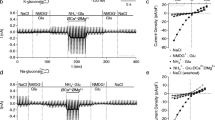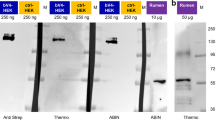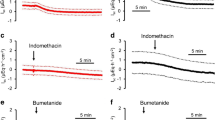Abstract
It has long been established that the absorption of short-chain fatty acids (SCFA) across epithelia stimulates sodium proton exchange. The apically released protons are not available as countercations for the basolateral efflux of SCFA anions and a suitable transport model is lacking. Patch clamp and microelectrode techniques were used to characterize an anion conductance expressed by cultured cells of the sheep and bovine rumen and the sheep omasum and to localize the conductance in the intact tissue. Cells were filled with a Na-gluconate solution and superfused with sodium salts of acetate, propionate, butyrate, or lactate. Reversal potential rose and whole cell current at +100 mV decreased with the size of the anion. Anion-induced currents could be blocked by diisothiocyanato-stilbene-2,2′-disulfonic acid (DIDS), NPPB (200 μmol l−1), or pCMB (1 mmol l−1). In patches of bovine ruminal cells, single channels were observed with a conductance for chloride (327 ± 11 pS), acetate (115 ± 8 pS), propionate (102 ± 10 pS), butyrate (81 ± 2 pS), and gluconate (44 ± 3 pS). Channels expressed by sheep rumen and omasum were similar. Microelectrode experiments suggest basolateral localization. In conclusion, forestomach epithelia express basolateral maxi-anion channels with a permeability sequence of chloride > acetate > propionate > butyrate. SCFA absorption may resemble functionally coupled transport of NaCl, with the Na+/K+-ATPase driving the basolateral efflux of the anion through a channel. Since protons are apically extruded, the model accurately predicts that influx of buffers with saliva is essential for the pH homeostasis of the ruminant forestomach.












Similar content being viewed by others
References
Abdoun K, Stumpff F, Rabbani I, Martens H (2010) Modulation of urea transport across sheep rumen epithelium in vitro by SCFA and CO2. Am J Physiol 298(2):G190–G202
Abdoun K, Stumpff F, Wolf K, Martens H (2005) Modulation of electroneutral Na transport in sheep rumen epithelium by luminal ammonia. Am J Physiol 289(3):G508–G520
Abdullaev IF, Rudkouskaya A, Schools GP, Kimelberg HK, Mongin AA (2006) Pharmacological comparison of swelling-activated excitatory amino acid release and Cl− currents in cultured rat astrocytes. J Physiol 572(Pt 3):677–689
Ali O, Shen Z, Tietjen U, Martens H (2006) Transport of acetate and sodium in sheep omasum: mutual, but asymmetric interactions. J Comp Physiol B 176(5):477–487
Allen MS (1997) Relationship between fermentation acid production in the rumen and the requirement for physically effective fiber. J Dairy Sci 80(7):1447–1462
Argenzio RA, Southworth M, Lowe JE, Stevens CE (1977) Interrelationship of Na, HCO3, and volatile fatty acid transport by equine large intestine. Am J Physiol 233(6):E469–E478
Aschenbach JR, Bilk S, Tadesse G, Stumpff F, Gabel G (2009) Bicarbonate-dependent and bicarbonate-independent mechanisms contribute to nondiffusive uptake of acetate in the ruminal epithelium of sheep. Am J Physiol Gastrointest Liver Physiol 296(5):G1098–G1107
Aschenbach JR, Penner GB, Stumpff F, Gabel G (2011) Role of fermentation acid absorption in the regulation of ruminal pH. J Anim Sci 89(4):1092–1107
Ash RW, Dobson A (1963) The effect of absorption on the acidity of rumen contents. J Physiol 169:39–61
Bajnath RB, Groot JA, de Jonge HR, Kansen M, Bijman J (1993) Calcium ionophore plus excision induce a large conductance chloride channel in membrane patches of human colon carcinoma cells HT-29 cl.19A. Experientia 49(4):313–316
Bell PD, Lapointe JY, Sabirov R, Hayashi S, Peti-Peterdi J, Manabe K, Kovacs G, Okada Y (2003) Macula densa cell signaling involves ATP release through a maxi anion channel. Proc Natl Acad Sci U S A 100(7):4322–4327
Bergman EN (1990) Energy contributions of volatile fatty acids from the gastrointestinal tract in various species. Physiol Rev 70(2):567–590
Binder HJ (2010) Role of colonic short-chain fatty acid transport in diarrhea. Annu Rev Physiol 72:297–313
Boron WF (1983) Transport of H+ and of ionic weak acids and bases. J Membr Biol 72(1–2):1–16
Boron WF, Boulpaep EL (2003) Medical physiology, 1st edn. Saunders, Philadelphia
Bouyer G, Cueff A, Egee S, Kmiecik J, Maksimova Y, Glogowska E, Gallagher PG, Thomas SL (2011) Erythrocyte peripheral type benzodiazepine receptor/voltage-dependent anion channels are upregulated by Plasmodium falciparum. Blood 118(8):2305–2312
Catalan MA, Flores CA, Gonzalez-Begne M, Zhang Y, Sepulveda FV, Melvin JE (2012) Severe defects in absorptive ion transport in distal colons of mice that lack ClC-2 channels. Gastroenterology 142(2):346–354
Chien WJ, Stevens CE (1972) Coupled active transport of Na and Cl across forestomach epithelium. Am J Physiol 223(4):997–1003
Danielli JF, Hitchcock WS, Marshal RA, Phillipson AT (1945) The mechanism of absorption from the rumen as exemplified by the behaviour of acetic, propionic, and butyric acids. J Exp Bio 22:75–84
Dengler F, Rackwitz R, Benesch F, Pfannkuche H, Gabel G (2013) Bicarbonate-dependent transport of acetate and butyrate across the basolateral membrane of sheep rumen epithelium. Acta Physiol (Oxf). doi:10.1111/apha.12155
Diener M, Scharrer E (1995) Swelling-activated conductances for chloride, potassium and amino acids in the rat colon: a whole-cell study. Exp Physiol 80(3):411–428
Diernaes L, Sehested J, Moller PD, Skadhauge E (1994) Sodium and chloride transport across the rumen epithelium of cattle in vitro: effect of short-chain fatty acids and amiloride. Exp Physiol 79(5):755–762
Dubyak GR (2012) Function without form: an ongoing search for maxi-anion channel proteins. Focus on “maxi-anion channel and pannexin 1 hemichannel constitute separate pathways for swelling-induced ATP release in murine L929 fibrosarcoma cells”. Am J Physiol Cell Physiol 303(9):C913–C915
Duran C, Thompson CH, Xiao Q, Hartzell HC (2010) Chloride channels: often enigmatic, rarely predictable. Annu Rev Physiol 72:95–121
Dutta AK, Sabirov RZ, Uramoto H, Okada Y (2004) Role of ATP-conductive anion channel in ATP release from neonatal rat cardiomyocytes in ischaemic or hypoxic conditions. J Physiol 559(Pt 3):799–812
Fromm M, Schultz SG (1981) Some properties of Cl-filled microelectrodes: correlation of potassium “leakage” with tip resistance. J Membr Biol 62(3):239–244
Gäbel G, Aschenbach JR, Müller F (2002) Transfer of energy substrates across the ruminal epithelium: implications and limitations. Anim Health Res Rev 3(1):15–30
Gäbel G, Bell M, Martens H (1989) The effect of low mucosal pH on sodium and chloride movement across the isolated rumen mucosa of sheep. Q J Exp Physiol 74(1):35–44
Gäbel G, Vogler S, Martens H (1991) Short-chain fatty acids and CO2 as regulators of Na+ and Cl− absorption in isolated sheep rumen mucosa. J Comp Physiol B 161(4):419–426
Gäbel G, Vogler S, Martens H (1993) Mechanisms of sodium and chloride transport across isolated sheep reticulum. Comp Biochem Physiol A 105(1):1–10
Gadsby DC (2009) Ion channels versus ion pumps: the principal difference, in principle. Nat Rev Mol Cell Biol 10(5):344–352
Glogowska E, Dyrda A, Cueff A, Bouyer G, Egee S, Bennekou P, Thomas SL (2010) Anion conductance of the human red cell is carried by a maxi-anion channel. Blood Cells Mol Dis 44(4):243–251
Graham C, Simmons NL (2005) Functional organization of the bovine rumen epithelium. Am J Physiol 288(1):R173–R181
Herschel DA, Argenzio RA, Southworth M, Stevens CE (1981) Absorption of volatile fatty acid, Na, and H2O by the colon of the dog. Am J Vet Res 42(7):1118–1124
Hille B (2001) Ion channels of excitable membranes, 3rd edn. Sinauer, Sunderland
Hume ID, Karasov WH, Darken BW (1993) Acetate, butyrate and proline uptake in the caecum and colon of prairie voles (Microtus ochrogaster). J Exp Biol 176:285–297
Islam MR, Uramoto H, Okada T, Sabirov RZ, Okada Y (2012) Maxi-anion channel and pannexin 1 hemichannel constitute separate pathways for swelling-induced ATP release in murine L929 fibrosarcoma cells. Am J Physiol Cell Physiol 303(9):C924–C935
Jackson M (1974) Intestinal SCFA transport. In: Smyth D (ed) Intestinal absorption, vol 4B, Biomembranes. Plenum, New York, pp 673–709
Kirat D, Masuoka J, Hayashi H, Iwano H, Yokota H, Taniyama H, Kato S (2006) Monocarboxylate transporter 1 (MCT1) plays a direct role in short-chain fatty acids absorption in caprine rumen. J Physiol 576(Pt 2):635–647
Kristensen NB (2005) Splanchnic metabolism of volatile fatty acids in the dairy cow. Anim Sci 80:3–10
Kristensen NB, Harmon DL (2004) Effect of increasing ruminal butyrate absorption on splanchnic metabolism of volatile fatty acids absorbed from the washed reticulorumen of steers. J Anim Sci 82(12):3549–3559
Kristensen NB, Pierzynowski SG, Danfaer A (2000) Net portal appearance of volatile fatty acids in sheep intraruminally infused with mixtures of acetate, propionate, isobutyrate, butyrate, and valerate. J Anim Sci 78(5):1372–1379
Kunzelmann K, Mall M (2002) Electrolyte transport in the mammalian colon: mechanisms and implications for disease. Physiol Rev 82(1):245–289
Kurbannazarova RS, Bessonova SV, Okada Y, Sabirov RZ (2011) Swelling-activated anion channels are essential for volume regulation of mouse thymocytes. Int J Mol Sci 12(12):9125–9137
Leonhard-Marek S, Breves G, Busche R (2006) Effect of chloride on pH microclimate and electrogenic Na+ absorption across the rumen epithelium of goat and sheep. Am J Physiol 291(2):G246–G252
Leonhard-Marek S, Stumpff F, Brinkmann I, Breves G, Martens H (2005) Basolateral Mg2+/Na+ exchange regulates apical nonselective cation channel in sheep rumen epithelium via cytosolic Mg2+. Am J Physiol 288(4):G630–G645
Liu HT, Sabirov RZ, Okada Y (2008) Oxygen–glucose deprivation induces ATP release via maxi-anion channels in astrocytes. Purinergic Signal 4(2):147–154
Liu HT, Tashmukhamedov BA, Inoue H, Okada Y, Sabirov RZ (2006) Roles of two types of anion channels in glutamate release from mouse astrocytes under ischemic or osmotic stress. Glia 54(5):343–357
Liu JH, Xu TT, Liu YJ, Zhu WY, Mao SY (2013) A high-grain diet causes massive disruption of ruminal epithelial tight junctions in goats. Am J Physiol Regul Integr Comp Physiol. 305(3):R232–R241. doi:10.1152/ajpregu.00068.2013
Luthi D, Günzel D, McGuigan JA (1999) Mg-ATP binding: its modification by spermine, the relevance to cytosolic Mg2+ buffering, changes in the intracellular ionized Mg2+ concentration and the estimation of Mg2+ by 31P-NMR. Exp Physiol 84(2):231–252
Martens H, Gabel G, Strozyk B (1991) Mechanism of electrically silent Na and Cl transport across the rumen epithelium of sheep. Exp Physiol 76(1):103–114
Masson MJ, Phillipson AT (1951) The absorption of acetate, propionate and butyrate from the rumen of sheep. J Physiol 113(2–3):189–206
Müller F, Huber K, Pfannkuche H, Aschenbach JR, Breves G, Gäbel G (2002) Transport of ketone bodies and lactate in the sheep ruminal epithelium by monocarboxylate transporter 1. Am J Physiol 283(5):G1139–G1146
Nagel W, Katz U (1997) Effects of NEM on voltage-activated chloride conductance in toad skin. J Membr Biol 159(2):127–135
Nilius B, Droogmans G (2003) Amazing chloride channels: an overview. Acta Physiol Scand 177(2):119–147
Orlowski J, Grinstein S (2004) Diversity of the mammalian sodium/proton exchanger SLC9 gene family. Pflugers Arch 447(5):549–565
Owens FN, Secrist DS, Hill WJ, Gill DR (1998) Acidosis in cattle: a review. J Anim Sci 76(1):275–286
Parthasarathy D, Phillipson AT (1953) The movement of potassium sodium, chloride and water across the rumen epithelium of sheep. J Physiol 121(3):452–469
Phillipson AT, McAnnally RA (1942) Studies on the fate of carbohydrates in the rumen of the sheep. J Exp Biol 19:199–214
Plaizier JC, Krause DO, Gozho GN, McBride BW (2008) Subacute ruminal acidosis in dairy cows: the physiological causes, incidence and consequences. Vet J 176(1):21–31
Ploger S, Stumpff F, Penner GB, Schulzke JD, Gabel G, Martens H, Shen Z, Gunzel D, Aschenbach JR (2012) Microbial butyrate and its role for barrier function in the gastrointestinal tract. Ann N Y Acad Sci 1258:52–59
Roth M, Obaidat A, Hagenbuch B (2012) OATPs, OATs and OCTs: the organic anion and cation transporters of the SLCO and SLC22A gene superfamilies. Br J Pharmacol 165(5):1260–1287
Roy CC, Kien CL, Bouthillier L, Levy E (2006) Short-chain fatty acids: ready for prime time? Nutr Clin Pract 21(4):351–366
Sabirov RZ, Merzlyak PG (2012) Plasmalemmal VDAC controversies and maxi-anion channel puzzle. Biochim Biophys Acta 1818(6):1570–1580
Sabirov RZ, Okada Y (2004) Wide nanoscopic pore of maxi-anion channel suits its function as an ATP-conductive pathway. Biophys J 87(3):1672–1685
Sabirov RZ, Okada Y (2009) The maxi-anion channel: a classical channel playing novel roles through an unidentified molecular entity. J Physiol Sci 59(1):3–21
Schmidt RF, Lang F, Thews G (2004) Physiology des Menschen. Springer, Heidelberg
Schweigel M, Martens H (2003) Anion-dependent Mg2+ influx and a role for a vacuolar H+ − ATPase in sheep ruminal epithelial cells. Am J Physiol Gastrointest Liver Physiol 285(1):G45–G53
Sehested J, Diernaes L, Moller PD, Skadhauge E (1993) Interaction between absorption of sodium and acetate across the rumen epithelium of cattle. Acta Vet Scand Suppl 89:107–108
Sehested J, Diernaes L, Moller PD, Skadhauge E (1996) Transport of sodium across the isolated bovine rumen epithelium: interaction with short-chain fatty acids, chloride and bicarbonate. Exp Physiol 81(1):79–94
Sehested J, Diernaes L, Moller PD, Skadhauge E (1999) Ruminal transport and metabolism of short-chain fatty acids (SCFA) in vitro: effect of SCFA chain length and pH. Comp Biochem Physiol A Mol Integr Physiol 123(4):359–368
Sehested J, Diernaes L, Moller PD, Skadhauge E (1999) Transport of butyrate across the isolated bovine rumen epithelium—interaction with sodium, chloride and bicarbonate. Comp Biochem Physiol A Mol Integr Physiol 123(4):399–408
Sellin JH (1999) SCFAs: the enigma of weak electrolyte transport in the colon. News Physiol Sci 14:58–64
Stauber T, Weinert S, Jentsch TJ (2012) Cell biology and physiology of CLC chloride channels and transporters. Compr Physiol 2(3):1701–1744
Steele MA, Croom J, Kahler M, AlZahal O, Hook SE, Plaizier K, McBride BW (2011) Bovine rumen epithelium undergoes rapid structural adaptations during grain-induced subacute ruminal acidosis. Am J Physiol Regul Integr Comp Physiol 300(6):R1515–R1523
Stolting G, Teodorescu G, Begemann B, Schubert J, Nabbout R, Toliat MR, Sander T, Nurnberg P, Lerche H, Fahlke C (2013) Regulation of ClC-2 gating by intracellular ATP. Pflugers Arch. 465(10):1423–1437. doi:10.1007/s00424-013-1286-0
Stumpff F, Georgi MI, Mundhenk L, Rabbani I, Fromm M, Martens H, Gunzel D (2011) Sheep rumen and omasum primary cultures and source epithelia: barrier function aligns with expression of tight junction proteins. J Exp Biol 214(Pt 17):2871–2882
Stumpff F, Martens H, Bilk S, Aschenbach JR, Gabel G (2009) Cultured ruminal epithelial cells express a large-conductance channel permeable to chloride, bicarbonate, and acetate. Pflugers Archiv (Eur J Physiol) 457(5):1003–1022
Toychiev AH, Sabirov RZ, Takahashi N, Ando-Akatsuka Y, Liu H, Shintani T, Noda M, Okada Y (2009) Activation of maxi-anion channel by protein tyrosine dephosphorylation. Am J Physiol Cell Physiol 297(4):C990–C1000
Vallejos C, Riquelme G (2007) The maxi-chloride channel in human syncytiotrophoblast: a pathway for taurine efflux in placental volume regulation? Placenta 28(11–12):1182–1191
Weigand E, Young JW, McGilliard AD (1972) Extent of butyrate metabolism by bovine ruminoreticulum epithelium and the relationship to absorption rate. J Dairy Sci 55(5):589–597
Yang W, Shen Z, Martens H (2012) An energy-rich diet enhances expression of Na+/H+ exchanger isoform 1 and 3 mRNA in rumen epithelium of goat. J Anim Sci 90(1):307–317
Acknowledgments
The expert technical assistance of Gisela Manz and Susanne Trappe is gratefully acknowledged. This study was generously supported by the Margarete Markus Charity and by the Schaumann Foundation.
Author information
Authors and Affiliations
Corresponding author
Rights and permissions
About this article
Cite this article
Georgi, M.I., Rosendahl, J., Ernst, F. et al. Epithelia of the ovine and bovine forestomach express basolateral maxi-anion channels permeable to the anions of short-chain fatty acids. Pflugers Arch - Eur J Physiol 466, 1689–1712 (2014). https://doi.org/10.1007/s00424-013-1386-x
Received:
Revised:
Accepted:
Published:
Issue Date:
DOI: https://doi.org/10.1007/s00424-013-1386-x




